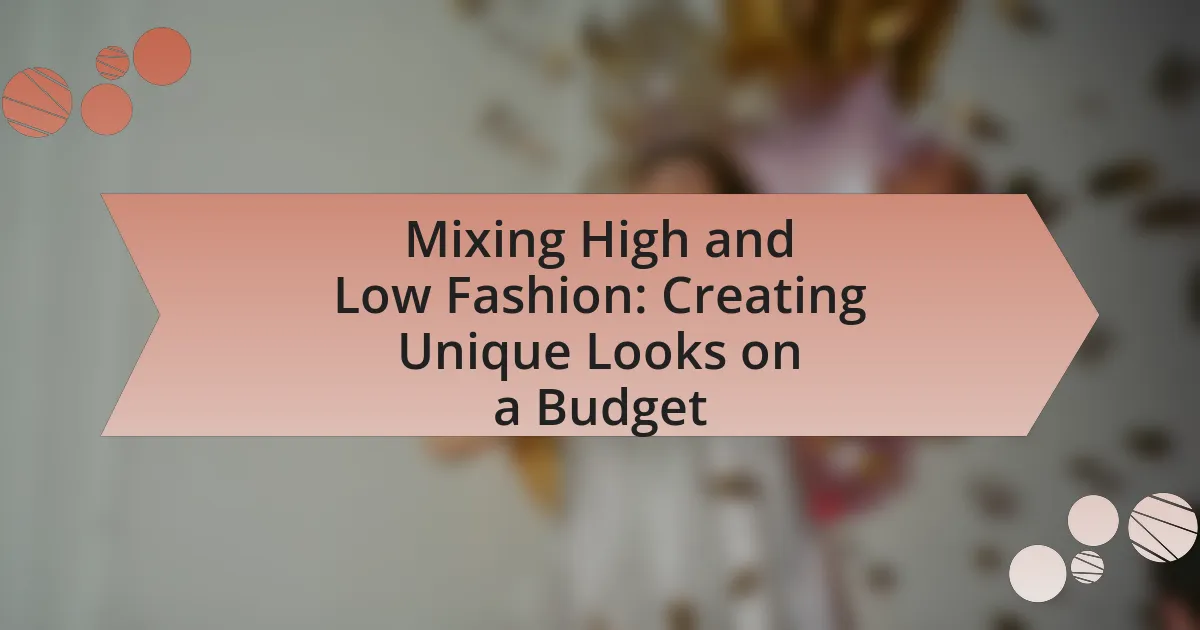Mixing high and low fashion involves the combination of luxury designer items with affordable clothing to create personalized and unique styles. This practice democratizes fashion, allowing individuals to express their creativity while managing their budgets effectively. Key elements of high fashion include exclusivity and craftsmanship, while low fashion emphasizes affordability and practicality. The article explores strategies for successfully blending these styles, the impact on personal expression and the fashion industry, and practical tips for creating stylish outfits on a budget, including thrift shopping and customization techniques. Additionally, it highlights the role of social media in shaping fashion choices and maintaining a stylish wardrobe without overspending.

What is Mixing High and Low Fashion?
Mixing high and low fashion refers to the practice of combining luxury designer pieces with more affordable, everyday clothing to create a unique and personalized style. This approach allows individuals to express their fashion sense without the need for a completely high-end wardrobe, making it accessible to a broader audience. The trend has gained popularity as it encourages creativity and individuality, enabling people to curate outfits that reflect their personal taste while managing their budget effectively.
How does Mixing High and Low Fashion work?
Mixing high and low fashion works by combining luxury items with more affordable pieces to create a balanced and unique style. This approach allows individuals to express their personal style without overspending, as high-end items can elevate the overall look while budget-friendly pieces provide versatility. For example, pairing a designer handbag with a basic t-shirt and jeans can create a chic outfit that feels both stylish and accessible. This method has gained popularity in fashion, as seen in street style trends and endorsements from fashion influencers who showcase how to blend these contrasting elements effectively.
What are the key elements of High Fashion?
The key elements of High Fashion include exclusivity, craftsmanship, innovation, and branding. Exclusivity is achieved through limited production runs and high price points, making items accessible only to a select clientele. Craftsmanship refers to the superior quality and attention to detail in materials and construction, often involving skilled artisans. Innovation is characterized by unique designs and trends that challenge conventional fashion norms, frequently showcased on runways. Branding plays a crucial role, as established fashion houses leverage their reputation to create desirability and loyalty among consumers. These elements collectively define High Fashion’s distinctiveness and appeal in the fashion industry.
What defines Low Fashion and its characteristics?
Low Fashion is defined as a style that emphasizes affordability, accessibility, and practicality in clothing, often characterized by the use of everyday materials and designs that prioritize comfort over high-end aesthetics. This fashion movement typically embraces thrifted items, DIY modifications, and mass-produced garments, making it a popular choice for individuals seeking unique looks without significant financial investment. The rise of social media platforms has further popularized Low Fashion, allowing individuals to showcase their personal style through creative combinations of inexpensive pieces, thus challenging traditional fashion hierarchies.
Why is Mixing High and Low Fashion important?
Mixing high and low fashion is important because it democratizes style, allowing individuals to express their creativity without financial constraints. This approach enables people to curate unique outfits that blend luxury items with affordable pieces, fostering personal expression and accessibility in fashion. For instance, a study by the Fashion Institute of Technology highlights that consumers increasingly seek individuality in their clothing choices, often turning to high-low combinations to achieve distinctive looks that reflect their personal style.
How does it promote individual style?
Mixing high and low fashion promotes individual style by allowing individuals to curate unique outfits that reflect their personal tastes and preferences. This approach encourages creativity, as it enables people to combine luxury items with more affordable pieces, resulting in distinctive looks that stand out. For example, pairing a designer handbag with thrifted clothing can showcase a person’s fashion sense while also making a statement about their values regarding sustainability and budget-consciousness. This blend of styles not only fosters self-expression but also empowers individuals to break traditional fashion norms, reinforcing the idea that personal style is not solely defined by price or brand.
What impact does it have on the fashion industry?
Mixing high and low fashion significantly democratizes the fashion industry by making stylish clothing accessible to a broader audience. This trend allows consumers to blend luxury items with affordable pieces, fostering creativity and personal expression in fashion choices. According to a 2020 report by McKinsey & Company, the rise of fast fashion and the blending of price points have reshaped consumer behavior, leading to increased demand for unique, personalized styles. This shift has prompted luxury brands to adapt their strategies, often collaborating with affordable brands to reach new markets and maintain relevance.

How can you effectively mix High and Low Fashion?
To effectively mix high and low fashion, combine luxury pieces with affordable items to create a balanced and stylish look. For instance, pairing a designer handbag with a budget-friendly outfit can elevate the overall appearance without compromising on style. This approach allows for personal expression while maintaining financial sensibility, as seen in fashion trends where influencers often showcase high-low combinations, demonstrating that style does not solely depend on price.
What are the best strategies for combining different fashion tiers?
The best strategies for combining different fashion tiers include balancing high-end pieces with affordable items, focusing on fit and quality, and accessorizing thoughtfully. By pairing a designer jacket with budget-friendly jeans, individuals can create a stylish look that appears polished without excessive spending. Prioritizing well-fitted garments enhances overall appearance, regardless of price, as evidenced by studies showing that fit significantly influences perceived value in fashion. Additionally, using accessories like statement jewelry or shoes can elevate a low-cost outfit, demonstrating that strategic choices can effectively merge high and low fashion.
How can accessories enhance a mixed outfit?
Accessories can enhance a mixed outfit by adding visual interest and personal style, bridging the gap between high and low fashion. For instance, a statement necklace can elevate a simple t-shirt and jeans combination, making it appear more polished and intentional. Additionally, accessories like belts, hats, or bags can introduce color, texture, and layers, which contribute to a more cohesive and dynamic look. Studies in fashion psychology indicate that accessories can influence perceptions of style and sophistication, reinforcing the idea that thoughtful accessory choices can significantly impact the overall aesthetic of an outfit.
What role does color coordination play in mixing styles?
Color coordination is essential in mixing styles as it creates visual harmony and coherence between different fashion elements. When high and low fashion pieces are combined, a well-coordinated color palette can unify diverse textures and silhouettes, making the overall look appear intentional rather than chaotic. For instance, a study by the University of California found that color harmony significantly influences perceptions of style and sophistication, suggesting that coordinated colors can elevate the aesthetic appeal of mixed outfits. Thus, effective color coordination not only enhances the visual impact but also reinforces the stylistic narrative when blending various fashion influences.
What are common mistakes to avoid when mixing styles?
Common mistakes to avoid when mixing styles include failing to maintain balance, neglecting color coordination, and overlooking the importance of fit. Maintaining balance ensures that one style does not overpower the other, which can create a disjointed look. Color coordination is crucial; clashing colors can detract from the overall aesthetic, making the outfit appear chaotic. Additionally, fit is essential; poorly fitting garments can undermine the intended style, regardless of the quality or design. These principles are supported by fashion experts who emphasize that a cohesive look requires attention to these elements for successful style mixing.
How can you ensure balance between High and Low Fashion pieces?
To ensure balance between high and low fashion pieces, strategically combine one statement piece from high fashion with several complementary low fashion items. This approach allows the high fashion item to stand out while the low fashion pieces provide a cohesive look. For example, pairing a designer handbag with a simple, affordable outfit can elevate the overall appearance without overwhelming the budget. Studies show that mixing high and low fashion can create a more personalized style, as seen in fashion trends where influencers often showcase this balance, making it accessible and appealing to a wider audience.
What should you consider regarding fit and silhouette?
When considering fit and silhouette, prioritize how clothing shapes and complements the body. A well-fitted garment enhances appearance and comfort, while the silhouette defines the overall style and visual impact of an outfit. For example, tailored pieces create a polished look, while loose-fitting items can convey a more relaxed vibe. Understanding body types and proportions is essential; certain silhouettes flatter specific shapes, such as A-line dresses for pear shapes or structured blazers for hourglass figures. This knowledge allows for effective mixing of high and low fashion, ensuring that budget-friendly items can still achieve a sophisticated look.

What are some practical tips for creating unique looks on a budget?
To create unique looks on a budget, individuals should focus on thrift shopping, DIY alterations, and accessorizing effectively. Thrift shopping allows for the discovery of one-of-a-kind pieces at low prices, often yielding vintage or unique items that stand out. DIY alterations, such as customizing or repurposing existing clothing, can transform basic garments into personalized styles, enhancing creativity without significant expense. Additionally, effective accessorizing with statement jewelry, scarves, or hats can elevate an outfit, making it appear more curated and stylish. According to a study by the Fashion Institute of Technology, incorporating accessories can significantly enhance the perceived value of an outfit, demonstrating that thoughtful additions can create a unique look without a high cost.
How can thrift shopping contribute to mixing fashion styles?
Thrift shopping contributes to mixing fashion styles by providing access to a diverse range of unique and vintage clothing items that are often not available in mainstream retail. This variety allows individuals to combine high-end pieces with low-cost finds, creating eclectic outfits that reflect personal style. For instance, a designer blazer can be paired with thrifted jeans and a vintage t-shirt, resulting in a distinctive look that showcases both luxury and affordability. Additionally, thrift stores often carry items from different eras and cultures, enabling shoppers to experiment with various aesthetics and trends, further enhancing their ability to mix styles creatively.
What are the best thrift store finds for High and Low Fashion?
The best thrift store finds for high fashion include designer clothing, vintage accessories, and unique statement pieces that can elevate an outfit. High-end brands often donate unsold items, making it possible to discover pieces from labels like Chanel, Gucci, or Prada at a fraction of their retail price. For low fashion, essential basics such as denim, t-shirts, and casual wear are commonly found, allowing for versatile layering and everyday looks. Thrift stores frequently stock items from fast fashion brands, providing affordable options that can be mixed with higher-end pieces to create a balanced wardrobe. This combination allows individuals to express their personal style while staying within budget.
How can you upcycle or customize Low Fashion items?
You can upcycle or customize Low Fashion items by altering their design, repurposing materials, or adding embellishments. For instance, transforming an oversized shirt into a fitted crop top involves cutting and sewing, while using fabric paint or patches can refresh a plain garment. Additionally, combining different fabrics or textures can create unique pieces, as seen in DIY fashion projects that often emphasize sustainability and creativity. According to a study by the Ellen MacArthur Foundation, upcycling contributes to reducing textile waste, highlighting its environmental benefits.
What are some online resources for budget-friendly fashion inspiration?
Some online resources for budget-friendly fashion inspiration include Pinterest, Instagram, and fashion blogs like The Budget Fashionista and College Fashion. Pinterest offers a vast array of visual ideas and DIY projects that cater to various styles while allowing users to save and organize their favorite looks. Instagram features influencers and everyday users showcasing affordable outfits, often tagging brands that offer budget-friendly options. The Budget Fashionista provides practical tips and outfit ideas specifically aimed at those looking to save money without sacrificing style, while College Fashion focuses on affordable fashion for students, offering styling advice and budget shopping guides. These platforms collectively provide a rich source of inspiration for creating unique looks on a budget.
How can social media platforms influence your fashion choices?
Social media platforms influence fashion choices by providing immediate access to trends, styles, and influencers. Users can observe real-time fashion updates from various sources, including celebrities and fashion bloggers, which shapes their preferences and purchasing decisions. For instance, a study by the Journal of Fashion Marketing and Management found that 70% of consumers are influenced by social media when making fashion purchases. This highlights the significant role social media plays in shaping individual fashion identities and choices.
What are the best practices for maintaining a stylish wardrobe on a budget?
To maintain a stylish wardrobe on a budget, prioritize quality over quantity by investing in versatile, timeless pieces that can be mixed and matched. This approach allows for the creation of various outfits without the need for excessive spending. Research indicates that a capsule wardrobe, which consists of a limited number of essential items, can reduce clothing costs while enhancing style (source: “The Capsule Wardrobe: 1,000 Outfits from 30 Pieces” by Wendy Mak). Additionally, shopping during sales, utilizing thrift stores, and exploring online marketplaces can provide access to high-quality items at lower prices, further supporting a stylish yet budget-conscious wardrobe.
